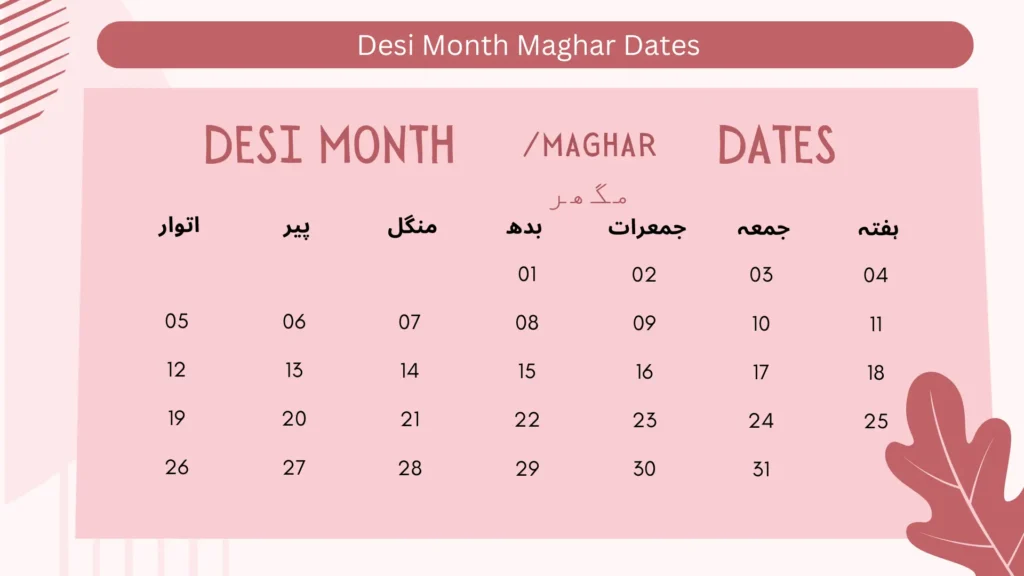Desi Month Maghar Dates 2024 Aligned with English (Gregorian) Dates
You can easily find the dates for the Desi month Maghar in 2024, matched with the English calendar. This helps you keep track of important dates for cultural, religious, or personal reasons. The Maghar dates are shown in both Desi and English formats, and you can even check Desi month date today, Sangrand, and Gurpurabs. Additionally, discover other Desi month dates for 2024: Chet, Vaisakhi, Jeth, Harh, Sawan, Badhon, Assu, Katak, Poh, Magh, and Phagun.
The Desi calendar, also known as the Punjabi calendar, is an essential part of the cultural and agricultural practices in the Indian subcontinent. Maghar, also known as Margashirsha, is the ninth month of this calendar and corresponds to 14th November to 13th December in the Gregorian calendar. This month is characterized by the onset of winter, significant agricultural activities, and various festivals celebrated by Muslims, Sikhs, and Hindus. This blog provides a detailed overview of the month of Maghar and its relevance in different calendars, weather patterns, agricultural significance, and cultural festivities.
Introduction to Desi Month Maghar in Various Calendars

- Desi Calendar (Punjabi Calendar): Desi month Maghar signifies the onset of winter and is crucial for the Rabi cropping season. This month is a month of hard work and preparation for the cold months ahead.
- Nanakshahi Calendar: The Nanakshahi calendar, adopted by the Sikh community, modernizes the ancient Bikrami calendar. Maghar in the Nanakshahi calendar aligns with 14th November to 13th December in the Gregorian calendar, encompassing important Sikh observances and celebrations.
- Bikrami Calendar: The Bikrami or Vikram Samvat calendar, an ancient lunar-solar calendar used in India and Nepal, includes Maghar as a significant month. It is a time for many traditional Hindu festivals and rituals, reflecting the region’s cultural richness.
Weather During Desi Maghar
Desi month Maghar is characterized by the arrival of winter, bringing significant changes in weather patterns:
- Temperature: The temperatures during Maghar range from 10°C (50°F) to 20°C (68°F). The days are typically calm and pleasant, while the nights can be pretty cold, particularly towards the end of the month.
- Rainfall: Maghar generally experiences minimal rain, which leads to dry conditions. Any precipitation is usually light and sporadic.
- Humidity: Humidity levels are lower compared to the monsoon and post-monsoon months, resulting in crisp and dry weather that is typical of winter.
- Agricultural Activities: This month is vital for the growth of Rabi crops. The cool, dry weather is ideal for wheat, barley, mustard, and other winter crops to thrive.
Festivals and Cultural Significance During Desi Maghar
Desi month Maghar is a culturally rich month with numerous festivals celebrated by Muslims, Sikhs, and Hindus. These festivals are deeply embedded in religious traditions and seasonal cycles.
- Muslim Festivals:
- Shab-e-Barat: Depending on the lunar calendar, Shab-e-Barat, the night of forgiveness, may fall in Maghar. It is observed with prayers, fasting, and seeking forgiveness from Allah.
- Sikh Festivals:
- Guru Nanak Dev Ji’s Joti Jot Divas: This day marks the death anniversary of Guru Nanak Dev Ji, the founder of Sikhism. Sikhs commemorate this day with prayers, kirtans (devotional songs), and langars (community meals).
- Shaheedi Divas of Guru Tegh Bahadur Ji: The martyrdom day of the ninth Sikh Guru, Guru Tegh Bahadur Ji, is observed in Maghar. Sikhs remember his sacrifice with prayers, kirtans, and special services in Gurdwaras.
- Hindu Festivals:
- Kartik Purnima: This festival, also known as Dev Deepawali, falls on the full moon day of Maghar. It is celebrated by lighting lamps, bathing in sacred rivers, and performing rituals to honor Lord Vishnu.
- Tulsi Vivah: This is a ceremonial marriage of the Tulsi plant (holy basil) to Lord Vishnu, symbolizing the end of the monsoon and the beginning of the wedding season in Hindu culture.
Agricultural Importance of Desi Month Maghar
The month of Maghar is significant for agriculture in the Indian subcontinent. Here are some critical aspects of its agricultural importance:
- Rabi Crop Growth: Desi month Maghar is crucial for the growth of Rabi crops. Farmers ensure these crops receive adequate water and nutrients during this critical growing phase.
- Soil Preparation and Maintenance: Farmers continue to prepare and maintain the soil for optimal crop growth. This includes weeding, applying fertilizers, and managing irrigation systems to support the healthy development of Rabi crops.
- Water Management: Effective water management practices are essential during Maghar to ensure adequate moisture for the crops. This includes the use of irrigation systems and water conservation techniques.
- Pest and Disease Control: During this month, farmers are vigilant about controlling pests and diseases to protect their crops and ensure a healthy harvest.
Traditional Practices and Rituals Desi Month Maghar
Desi month Maghar is rich in traditional practices and rituals that reflect the region’s cultural heritage and agricultural cycles. These practices are often intertwined with religious beliefs and seasonal changes:
- Religious Observances: During the various festivals in Maghar, special prayers, fasting, and rituals are expected. These practices seek divine blessings for prosperity, health, and good harvests.
- Folk Songs and Dances: Maghar’s cultural vibrancy is reflected in folk songs and dances celebrating the winter, agricultural activities, and festivals. These performances are an integral part of community gatherings and celebrations.
- Ritual Offerings: Farmers and families make offerings to deities and nature spirits, seeking protection and blessings for their crops and households. These offerings often include grains, fruits, and flowers.
- Community Feasts: Festivals during Maghar are often accompanied by communal meals, where families and communities come together to share food and celebrate. These feasts strengthen social bonds and promote a sense of unity.
Conclusion
The Desi month of Maghar, from 14th November to 13th December, is a period of great cultural, religious, and agricultural significance in the Indian subcontinent. It marks the onset of winter, bringing cooler and drier weather ideal for the growth of Rabi crops and the continuation of various agricultural activities.
Festivals such as Shab-e-Barat, Guru Nanak Dev Ji’s Joti Jot Divas, the Shaheedi Divas of Guru Tegh Bahadur Ji, Kartik Purnima, and Tulsi Vivah bring communities together in celebration, reflecting the region’s rich cultural diversity. Traditional practices and rituals during Maghar highlight the deep connection between nature, agriculture, and religion, showcasing the people’s resilience and adaptability.
Understanding the significance of Maghar helps us appreciate the intricate relationship between the natural cycles of the earth and the cultural practices of communities. As we delve into the rhythms of this desi month, we gain insights into the vibrant and dynamic traditions that have sustained and enriched the lives of people in the Indian subcontinent for centuries.
